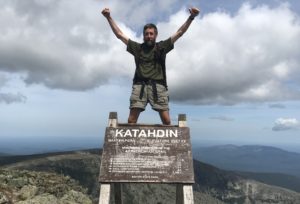
Allegheny Alumnus Reaches the Heights of the Appalachian Trail
This was no stroll in the park. It was a five-month, 2,192-mile grind that tested the mettle of David Gallogly. But in the end, on August 27, 2019, Gallogly stood triumphantly on the summit of Mount Katahdin in Maine, 164 days after setting out from the southern terminus of the Appalachian National Scenic Trail.
“I had to force my body to climb up and down mountains each day with a 30-pound pack on my back,” said Gallogly, a 1985 graduate of Allegheny College. “Some days were downright grueling but the views and sense of accomplishment made it totally worthwhile.”
The most scenic places along the trail included Mount Katahdin and Mount Hight in the White Mountains of New Hampshire, Gallogly said. “The reason I enjoyed Mount Hight over, say, Mount Washington, is that my trail group ‘cowboy camped’ on top of that mountain and watched the sun set then rise the next morning with a star-studded sky in between,” he said. Gallogly’s third favorite scenic site was Lookout Mountain in Vermont.

Gallogly, who lives in Allison Park, Pennsylvania, decided to undertake the adventure after he became an “empty nester” and sold his environmental laboratory business. He embarked on his trek on March 17 at Springer Mountain in Georgia.
Most days on the trail started “with the chirping of the birds that served as my alarm clock,” Gallogly said. That would usually be around 4:45 a.m. Gallogly would rise, deflate his pillow and sleeping mat and grab a quick breakfast, which generally included coffee and a high-calorie pastry such as honey buns or bear claws. “Early on, I made oatmeal for breakfast but didn’t like the extra cooking time and the messy pot,” he says.
After taking down his tent and packing his gear, Gallogly was on the trail by 7 a.m. “I enjoyed the mornings and would usually hike until noon and then stop an hour for lunch,” he says, which would include something like tuna fish or cheese on a flour tortilla. “Throughout the day, I would munch on protein bars or some other type of fruit-and-nut bar.”
On most days, he would stop hiking around 4 or 5 p.m. and pitch his tent. It also was time for a very important daily task — collecting and filtering water in three one-liter bottles. Dinner would consist of ramen noodles with tuna or Knorr pasta sides with (again) tuna. “Once in a while, I would treat myself to a dehydrated dinner like spaghetti or beef stew,” Gallogly says.
After cleaning up, he would make an entry in his journal and hit the sack. “That time of day is referred to as ‘hiker midnight’ and most thru-hikers honor the quiet time when things get dark,” he says.
Gallogly’s average daily hike was 15 miles, but it ranged from just three miles — if he had to head into a town for resupply of his provisions — to 25 miles on a good day.
He also “took off” for 14 days that are known as “zero” days, he says. Those days he spent with family members, including his wife, Stephanie, who visited twice, and his oldest son, who accompanied him for three days on the trail. Both his sons, Jake and Isaac, joined him on Katahdin on his final day.
He was not for want of companionship on the trail. “I typically hiked alone but would encounter other hikers every day. A few times I camped alone but that was only possible at a ‘stealth’ site. The official campsites are either a shelter or designated tent area. My preference was to hike alone but camp with others,” Gallogly says. “Contrary to common thought, it is not a solo wilderness adventure and requires quite a bit of social interaction.”
He also saw his share of wildlife along the way: eight black bears, and numerous beaver, porcupine, moose, deer, birds, and the sounds of coyotes and owls at night, Gallogly says. He also came upon a lynx in Maine, which he initially mistook for a dog. “It was bigger than a bobcat but smaller than a mountain lion. It watched me for a few minutes and then disappeared into the woods.”
Bears can get aggressive and trail administrators often post notices for hikers to be “bear wary,” especially around campgrounds. The Appalachian Trail website routinely posts warnings for bears and occasionally closes campsites that are plagued by aggressive animals. Right after he had made it through an area of Vermont, Gallogly says park rangers had to kill a bear that had approached people, destroyed a privy, entered a shelter and stole a hiker’s backpack. “As you can imagine, it was the subject of discussion for many days up and down the trail,” he says.
The Appalachian Trail Conservancy estimated that 4,500 hikers attempted to make the entire trek in 2019, but that only one-quarter of the group would actually accomplish the feat.
While Gallogly did see some fellow hikers incur trek-ending injuries on the trail, he did not suffer any serious mishaps. “I was fortunate, although my feet and knees hurt and I was sore like everyone else,” he says.
Those who hike the Appalachian Trail must have a steely resolve, Gallogly advised. “I never considered giving up but there were times when I questioned my decision to do the whole trail in one season,” he says. “I recall a cold evening in the Smoky Mountains when I said out loud, “This sucks.” Another down time was hiking through a few days of rain in Pennsylvania. I missed being with my wife and family the most. After that, I missed my bed.”